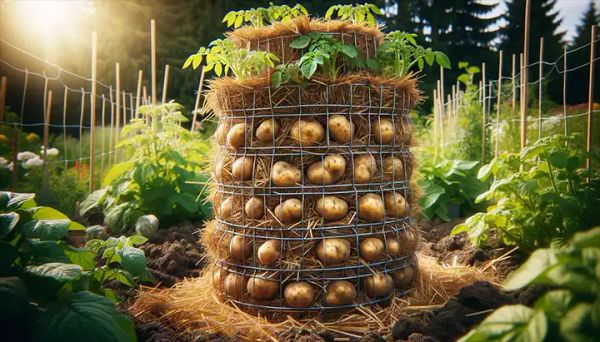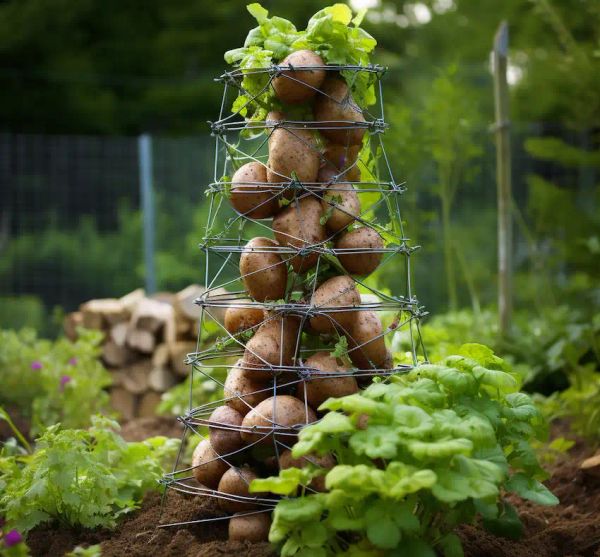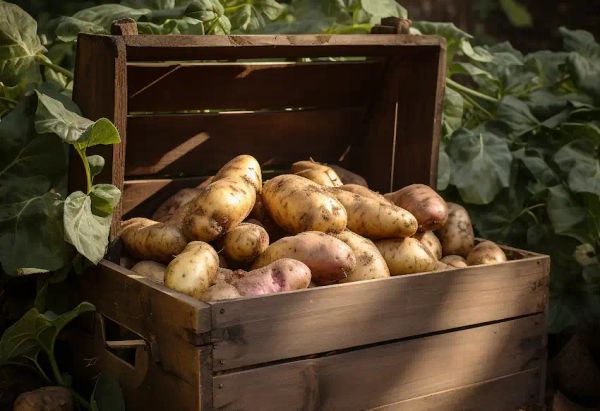Growing potatoes in a limited space can be a challenge, especially for those with smaller gardens or balconies. But don’t worry, there’s a solution: the potato tower! In this guide, we will walk you through the steps of building a potato tower using straw, and explain all the benefits that come with it.

Benefits of a Potato Tower
Potato towers offer several advantages that make them perfect for small spaces:
1. Space Efficiency: Potato towers require minimal ground space, making them ideal for small gardens or balconies.
2. Ease of Harvest: Harvesting potatoes from a tower is much easier than digging them out of the ground. No more back-breaking work!
3. Reduced Pest and Disease Risk: Elevating the growing medium helps protect the crop from soil-borne pests and diseases. Say goodbye to those pesky invaders!
4. Improved Drainage and Aeration: The structure of a tower allows for better air and water flow, which is crucial for healthy potato growth. No more soggy soil!
Materials Needed
Before we dive into the step-by-step guide, let’s make sure you have everything you need:
- Wire fencing or a large mesh cylinder

- Straw, preferably weed-free
- Compost and soil
- Seed potatoes
- Watering can or hose
- Gardening gloves
Step-by-Step Guide to Building a Potato Tower
Now let’s get started on building your very own potato tower:
Choose a Sunny Location
Potatoes love sunlight, so find a spot that gets at least 6 hours of direct sunlight daily.
Prepare the Tower Structure
- Cut a piece of wire fencing to create a cylinder about 2 to 3 feet in diameter and 3 to 4 feet high.
- Secure the edges to form the tower.
Layer the Base
- Begin by adding a layer of straw at the bottom of the tower for drainage.
- Then, add a mix of soil and compost, creating a layer about 6 inches deep.
Plant Seed Potatoes

- Place the seed potatoes on top of the soil layer, making sure the eyes are facing upward.
- Space them about 6 inches apart.
- Cover the potatoes with another layer of soil and compost.
Continue Building Up
- As the potato plants grow, keep adding layers of straw around the sides of the tower, and more soil-compost mix to cover the stems. Leave only the top few inches of the plant exposed.
- This method encourages more potatoes to form along the buried stems.
Watering and Care
- It’s important to water the tower regularly, keeping the soil moist but not waterlogged.
- Be careful not to over-water, as it can lead to rot.
Harvesting
- Your potatoes are ready to harvest once the foliage starts to yellow and die back.
- Gently remove the straw and soil from the sides of the tower to access the potatoes.

Additional Tips
Here are a few extra tips to help you get the most out of your potato tower:
- Choosing Potatoes: Use certified seed potatoes to reduce the risk of disease.
- Tower Placement: If mobility is a concern, place the tower on a platform with wheels for easy movement.
- Monitoring for Pests: Regularly check for signs of pests and address them promptly to ensure a healthy crop.
Building a potato tower is a fun and rewarding project for gardeners of all ages. It’s an innovative way to grow a staple crop in a limited space, with the added benefits of easy care and harvest. By following these steps, you’ll enjoy a bountiful potato harvest that’s both efficient and enjoyable. Happy gardening!




